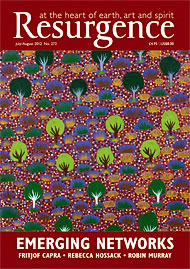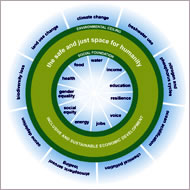In 2009, Johan Rockström of the Stockholm Resilience Centre (which studies the governance of socio-ecological systems) brought together a group of leading Earth-system scientists, and they came up with the concept of ‘planetary boundaries’ – an idea that is opening up many new perspectives on sustainability.
The scientists started out by identifying a set of nine Earth-system processes – including the freshwater cycle, biodiversity, climate regulation and the nitrogen cycle – that are critical for keeping the planet in the stable state of the Holocene that has enabled human civilisations to arise and thrive over the past 10,000 years. Under too much pressure from human activity, any one of these processes could be tipped into abrupt and even irreversible change – with the risk of pushing humanity out of the Holocene.
To avoid that risk, the scientists proposed a boundary below the danger zone of each process (such as setting a limit of 350 parts per million of carbon dioxide in the atmosphere to prevent dangerous climate change). Together, the nine boundaries can be drawn as a circle, the middle part of which Rockström and the others have called “a safe operating space for humanity”.
It’s a fantastic idea. For decades, the economist Herman Daly and other alternative thinkers have argued eloquently that economics – which is so very influential in policymaking – must recognise that the economy is embedded in the environment and is dependent upon it for providing resources and absorbing pollutants. Now natural scientists have stepped in and provided a powerful, quantified picture of this: a set of boundaries within which the global economy should operate – boundaries described not in terms of monetary metrics, but in terms of the natural metrics that are fundamental to the planet’s wellbeing.
And yet something critical is still missing. This “safe operating space” may protect the environment, but it may also leave many millions of people exposed to extreme poverty and deep social inequality. We cannot hope to achieve global sustainability unless we simultaneously pursue far greater global equity. So how about adding the concept of social boundaries to the picture? Just as there is an environmental ceiling of resource use, above which lies unacceptable environmental degradation, so too there is a social foundation of resource use, below which lies unacceptable human deprivation.
What kinds of deprivation are we talking about? Human rights provide the cornerstone for defining this – and a first indication of the most critical deprivations to be tackled as 21st-century priorities comes from the social issues raised by the world’s governments in their official submissions to the recent Rio+20 conference. They highlighted 11 social deprivations – such as lack of food, water, healthcare, resilience, voice, and social equity – which together constitute the social foundation in the graphic below.
Between the social foundation and the environmental ceiling lies a space – shaped like a doughnut – which is both the safe and the just space for humanity. And when these social and planetary boundaries are the starting point, the role of economics is transformed. Its aim must be to create inclusive and sustainable economic development that can bring humanity into this safe and just space, and enable us all to thrive there.
Every compass needs a needle – and boundaries need metrics. Rockström and his colleagues stuck their necks out when they had a first go at quantifying seven of the nine planetary boundaries (acknowledging huge uncertainties in doing so) and estimated that three have already been dangerously crossed: those for climate change, biodiversity loss, and nitrogen use. So I stuck my neck out, too, and estimated that humanity is far below the social foundation on all eight dimensions (see the accompanying doughnut graphic) for which data are available. The outcome is a glaring sign of just how deeply unequal, and unsustainable, the current path of global development is.
But even more extraordinary is the good news that bringing everyone alive today out of deprivation need not stress planetary boundaries. Providing the additional calories needed by the 13% of the world’s population facing hunger would require around 1% of the current global food supply. Bringing electricity to the 19% of people who currently live without it could be achieved with less than a 1% increase in global CO2 emissions. And ending income poverty for the 21% of people who live on less than US$1.25 a day would require just 0.2% of global income.
The real source of stress on the planet is excessive resource use by roughly the richest 10% of people in the world – backed up by the aspirations of a rapidly growing global middle class seeking to emulate those unsustainable lifestyles. This is where deep transformation must begin.
This framework of planetary and social boundaries is gaining interest around the world – perhaps because it provides a new perspective on sustainability and equity, without claiming to provide all the answers. It certainly prompts some of the big questions that need asking. Who should determine the dimensions and boundaries of an internationally agreed social foundation? What major policy shifts are required to create economic development that brings humanity within social and planetary boundaries? And what does the doughnut imply about the fair shares of effort needed, between and within countries, for getting into that safe and just space?
Big questions – but now is the time for humanity to starting coming up with big answers.
For a short video introducing social and planetary boundaries, and for the full discussion paper, visit www.tinyurl.com/oxfamdoughnut2012, www.oxfam.org








